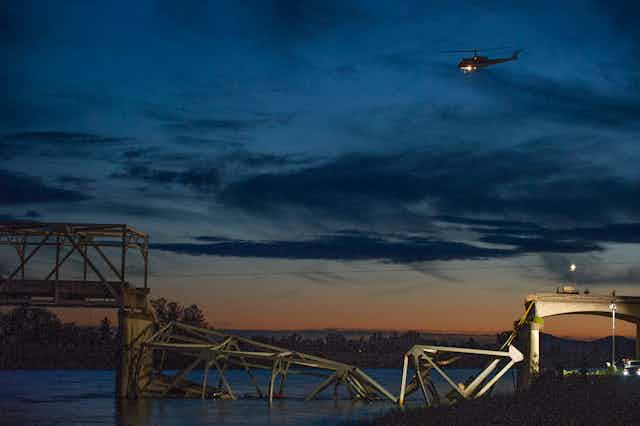Bridge collapses are often tragic, but are also fascinating for bridge engineers as they usually provide puzzles to solve and often lead to major changes in design, construction and management.
Complete bridge collapses, such as the the highway bridge that collapsed in Washington State last week and the Minneapolis I35 West Bridge in 2007, are relatively rare.
The cause of the Washington bridge collapse is obvious; an oversize truck collided with critical structural elements. Others, like I35W, the Tacoma Narrows Bridge (the famous Galloping Gertie, also in Washington State) that broke apart during normal wind conditions, and Palau Bridge, require significant detective skills as advanced as those used in aircraft crash investigations.

Design flaws
I35W collapsed because of overloading during construction and the faulty design of a small but critical structural component. Galloping Gertie collapsed because of trends towards efficient design of North American long-span bridges and because memories of similar wind-driven collapses in Europe and USA had become too distant. Palau Bridge also appears to have collapsed due to inadequate design.
Other reasons for total collapse include vehicle overload, scour and collapse of bridge piers, metal corrosion and fatigue, defective material (increasingly rare), impact by a vehicle as in this most recent case, neglect and general deterioration.
In the distant past footbridges have been destroyed by pedestrian action for example soldiers marching in step, but this is a well understood problem these days and the worst case result is embarrassment and litigation.
Natural causes
There are also well known examples of bridge collapse due to flooding (for example in Cumbria in 2009), earthquakes, and very rarely these days due to excessive winds.

Design codes engineers need to follow (by law or otherwise) prescribe “actions” specific to location, such as maximum credible earthquake and wind speed. Designs must take these actions into account in combination with other more common forms of loading (for example from vehicles and or due to temperature).
Bridges still collapse during earthquakes because older designs missed out on important new understandings about the way structures work in earthquakes and have not been upgraded. And by their very nature earthquakes are random events; history does not provide enough information to assess precise seismic hazard everywhere structures are built, so we learn by (painful) experience.
But we learn directly from earthquake-induced failures. Causes of bridge collapse during earthquakes are studied by forensic structural engineers from around the world through post-earthquake missions.
As well as bridges in operation, there have also been many cases of bridge collapse during construction, such as at Kota, India in 2008. The causes of these collapses are more complex, due to the timing and interaction of the various construction methods and the increased possibility for human error.
The element of surprise
It is also worth remembering that to an engineer, failure and collapse have different meanings. The London Millennium Bridge did not collapse, but it still failed. It was not fit for purpose until a costly retrofit made it immune to the lateral forces generated by pedestrian crowds.

Structural trauma caused by earthquakes, floods and fire may not result in total collapse but can seriously damage or weaken a bridge.
Other problems may be less obviously destructive and come with the element of surprise discovery. Corrosion is a major threat to bridges. It led to the closure of Hammersmith flyover at a critical time before the London 2012 Olympics.
With a bridge still standing and even in restricted operation, assessing its condition under conflicting requirements for safety and minimising disruption can provide greater challenges for structural engineers than for bridges that have completely collapsed.
Keeping bridges up
So how can engineers prevent bridge collapse, and how can engineers know if a bridge has deteriorated or suffered damage that compromises safety of users?
These are two rather different issues. In the first case, design codes and safety factors provide comfort zones in which engineers can operate. When designs become clever (for example Tacoma Narrows and the London Millennium Bridge) factors that have worked to keep simpler designs safe may be lost.
Our experience of different types of loading (for example from winds or earthquake) is constantly enhanced. Design guidance is constantly revised and risk is reduced. In cases of exceptional landmark structures, experimental studies on sophisticated models may be carried out using laboratory tools such as wind tunnels, shaking tables and centrifuges, further reducing the possibility for surprise.
With modern methodologies and safe working requirements, construction accidents are increasingly rare in developed countries. However with realistic economic constraints it is all but impossible to guard against “low probability, high impact” events such as terrorism, freak vehicle accidents and weather.

For structures that age, deteriorate and have to carry ever increasing loads, and in the case of bridges that have partially failed or been damaged due to trauma, there are emerging technologies to assist engineers in a similar way to medical diagnostics.
Researchers worldwide and agencies such as US Federal Highway Administration are taking steps to develop technologies that improve the way engineers manage bridges to maintain safety, reduce costs and cope with increased demand.
This technology is only being adopted very slowly, but there are some striking examples in major long span structures throughout the world.
Forth Replacement Crossing in Scotland will have a highly sophisticated performance and health monitoring system based on designs that have been in operation in Hong Kong for more than a decade. Such systems are largely intended to check whether structures are behaving (performing) as designers intended.
There is still a long way to go before such technologies can replace manual inspections and the skills and efforts of bridge maintenance engineers, but exciting developments in sensors and data interpretation technology show great promise.

